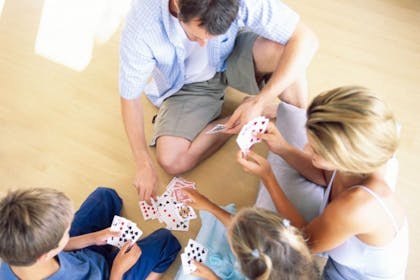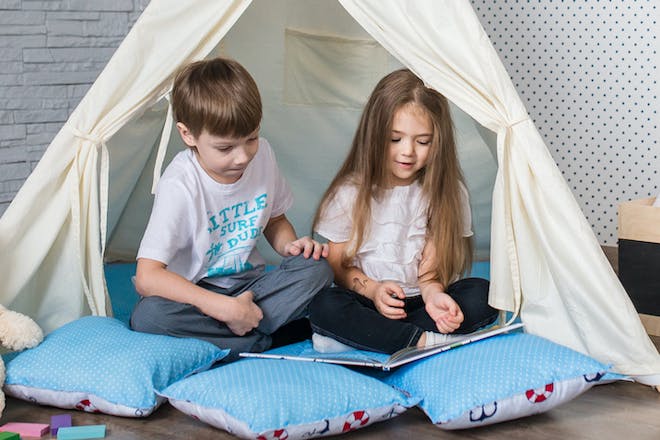Saving money with a night in? These brilliant card games for kids will help to keep the whole family entertained.
This page contains affiliate links, which means we may earn a small amount of money if a reader clicks through and makes a purchase. All our articles and reviews are written independently by the Netmums editorial team.
It's time to get old-school and dust off the playing cards, for hours of entertainment... that's completely free!
Not only are card games a great way to give your kids some screen-free time , they can even help with learning numbers and basic maths skills.
Younger and older kids alike will delight in these family-friendly card games.
Of course, a deck (or two) of cards will be needed, so we recommend this handy and affordable set that you can get here at Amazon for £6.95 .
1. Snap
Age range: 3+
Players: 2+
How to play:
Deal out the whole pack between the players.
The players then take it in turn to place cards down in a pile in the middle.
When two people put down matching cards (e.g. a pair of twos or a pair of Kings, etc...), the first person to shout SNAP wins the pile and puts them to the bottom of their stack.
The winner is ...
The last person still holding cards, when everyone else has put down all their cards.
Variation
Try playing this game with pictures of animals. Instead of shouting SNAP, players have to make the noise of the matching animal. For example, if two sheep cards are played, the winner is the first one to shout BAAAH.
2. Beggar My Neighbour
Age range: 5+
Players: 2+ (if you have more than three players, use two decks of cards)
How to play:
Deal out all the cards between the players.
Take it in turns to turn one over from the top of your pile and put it on the table (as with Snap.)
If you turn over a Jack, Queen, King or Ace, the next player must put down more cards as follows:
- Jack - one card
- Queen - two cards
- King - three cards
- Ace - four cards
If no picture cards are turned over in this time, you collect all the cards from the table and put them at the bottom of your pile.
However, if a picture card WAS turned over, your opponent immediately stops their 'pay out' of cards.
Instead, the next person has to put down one, two, three or four cards, according to the rank, as above.
This continues until one player has won all the cards.
The winner is ...
The person who wins the whole pack of cards.
Variation
Sometimes, it can take forever for someone to win all the cards. To make sure you don't get stuck in a permanent loop, you could consider making it a timed game, with the winner being whoever has the most cards left after 10-15 minutes.
3. Go Fish
Age range: 4+
Players: 2+
How to play:
Deal five cards to each player. Put the remainder face down in the middle of the table.
You take it in turns to ask other players for cards, and the aim is to get as many sets of four as possible before the game finishes.
When it's your turn, you can ask anyone for a card, as long as you have a card of that number or rank in your hand.
If they have one or more cards that you've asked for they have to give it to you. Then you get another go and repeat the above.
However, if you ask for something and the person hasn't got it they must shout 'Go Fish!'
You then pick a card up from the centre pile. If the card you pick up happens to be the same as the one you'd just asked for, then you continue your go. Otherwise the person who said 'Go Fish' has a turn next.
When you have four cards that match (e.g. four Kings), lay them down on the table.
The winner is ...
The game finishes when all cards have been laid down in sets of four - the person with the most sets wins.
Variation
To give your kids more of a sense of achievement, aim to collect pairs rather than set of four.
4. Old Maid
Age range: 4+
Players: 2+
How to play:
Start the game by removing one of the Queens from a pack, then deal the remaining cards evenly between the players (don't worry if some players have one or two more cards than others).
Each player picks up their cards and removes all pairs (e.g. two Kings) and puts them face down in front of them.
If a player has three of a kind, he removes only two of those three cards.
The person on the left of the dealer then takes one of the dealer's cards (without looking at it). If they can make a pair, they do so and then they offer their remaining cards to the person on their left, who takes one.
The winner is ...
This continues until all cards have been paired except one - and the player who has that card is the Old Maid!
Variation
To make things even trickier for older kids, change the rules so that pairs have to be the same colour. So for example, the two of spades can only be matched with the two of clubs, and the two of hearts can only be matched with the two of diamonds.
5. Memory
Age range: 3+
Players: 1+
How to play:
Spread out a pack of cards face-down on the table or floor.
The first player turns over two cards, letting all the players see them. If the cards match (for example, a pair of twos), the player picks them up and keeps them. If they don't match, the player turns them face-down again, and play moves to the next player on the left.
The winner is...
When all the cards have been paired up, whoever has the most pairs is the winner.
Variation
This can also be a great solo game:
For older kids, get them to count how many turns it takes them to pair up all the cards, then try to beat their personal best.
For younger kids, give them two containers: one filled with buttons and one empty. Every time they take a turn, they move one button from the full container to the empty one. Can they pair up all the cards before the first container is empty? (Just be sure the buttons aren't small enough to be a choking hazard for very young kids)
6. Snip, Snap, Snorem
Age range: 3+
Players: 3+
How to play:
Deal out the cards evenly among the players (don't worry if some players have one or two more than others).
Each player should then organise their cards in number order, from Ace to King (this makes the game much simpler).
The first player starts by putting down any card. The next player looks to see if they have any cards of the same number. If so, they put them down - if not, play passes to the next player.
When a player puts down the second card with a particular number, they say 'Snip' as they do so. For the third, it's 'Snap'. When the final card of that number is placed down, the player says 'Snorem' - that player is then allowed to put down any card, starting the play off again.
The winner is...
Whoever gets rid of all their cards first.
7. Slapjack
Age range: 4+
Players 3-6
Deal out the cards evenly to all players (don't worry if some have one or two more cards than others).
Take it in turns to place a card face-up on the table.
When a Jack appears, all players try to be first to slap their hands down on the pile of cards and yell 'Slapjack!'
Whoever gets there first wins all the cards.
The winner is...
The player left holding all the cards.
Variation
To liven things up, add extra rules for what people can call out if other royal cards appear, such as Slapqueen for a Queen. Remembering to shout the right word can be trickier than it seems!
8. Pig
Age range: 4+
Players: 3+
How to play:
Deal out four cards to each player.
The players look at their cards, then each player passes one card to the left and picks up the card passed by the player on his right. The aim is to get four cards with the same number or rank.
This passing continues as rapidly as possible so that players find it difficult to keep up.
As soon as a player has four of the same in their hand (all threes for example), they stop passing or picking up cards and put a finger to their nose.
The other players must now stop and touch their nose too.
The winner is ...
The last person to touch their nose is the Pig. They then sit out while everyone else plays again. The rounds continue until you have just one player left: the winner.
9. Solitaire
Age range: 7+
Players: 1
How to play:
Yes, everyone's favourite Windows game can also be played with real cards: who knew? Perfect for older kids to buy you a few minutes' peace.
First, deal the cards:
- In a row from left to right, lay out one card face up, then six cards face down.
- Lay one card face up on top of the second card (slightly overlapping), then five more cards face-down on top of the other cards.
- Repeat until the seventh pile has seven cards, with the bottom one facing up.
- Place the remaining cards face-down near the piles.
- Leave room for four 'foundation piles' - one pile for each suit (e.g. one for hearts, one for spades, etc...).
Now you can get started. The ultimate aim is to move all the cards to the foundation piles, but first, you'll need to move the cards around a bit.
Cards can be stacked in number order, with alternating suits. So, for example, a red two can go on top of a black three; a black Queen can go on top of a red King. When a pile is empty, any King can be placed in the empty space.
When you uncover an Ace, move it to one of the foundation piles. These are stacked in reverse number order, so the two of hearts goes on top of the Ace of hearts, etc.
When you can't make any more moves, turn over one of the cards from the pile of remaining cards. If you can, place it on one of the piles - if not, turn over another card. Once all cards have been turned over, you can turn the pack upside-down and start again.
The winner is ...
The game ends once all the cards are in the foundational piles. Bear in mind that it's not always possible to win at solitaire (a great life lesson for us all)!
Variation
To make the game harder for older kids, turn over three cards at a time from the remaining cards. Alternatively, once all the remaining cards are turned over, they can't then be turned upside-down and used again.
10. Predictions
Age range: 3+
Players: 2-3
How to play:
All the cards are dealt out between two or three players. Take it in turns to place your top card on the table.
Just before you turn over your top card, you must say a number or rank of card out loud (e.g. 'two' or 'King').
You are trying to predict what the next card will NOT be.
You are not allowed to keep saying the same number over and over, or say what the previous person said.
Other than that, it's entirely up to you.
The winner is ...
If you call out a card number and the one you turn over matches, you're out of the game.
The aim is to get rid of all your cards without predicting any of them (Sounds easy? Give it a go.)
11. Top Trumps
Age range: 4+
Players: 2+
How to play:
For this game, you'll need special Top Trumps cards, available from Amazon.
Deal all the cards to each player, face down.
Each player holds their cards so that they can see the top card only.
The player to the dealer’s left starts by reading out a statistic from their top card. The other players then read out the same statistic.
The player with the highest number wins all the other players' top cards and moves them to the bottom of their pile.
They then choose a statistic again from the next card.
If two or more cards share the top value, all the cards are placed in the middle and the same player chooses again from the next card.
The winner is ...
The person with all the cards at the end is the winner.
What are your favourite indoor activities to keep the kids occupied? Get more ideas and share your tips in our Coffeehouse Forum, below.
Related stories
100 activities if you're stuck indoors with kids
CHAT: activities to do at home
The best board games to play with your children







